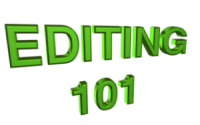 Punctuating Prepositional and Appositive Phrases
Punctuating Prepositional and Appositive Phrases
Wow! That’s a mouthful, eh? I guess we’d better start with definitions before we talk about punctuation.
A prepositional phrase starts with a preposition. Prepositions are words that indicate location—usually in the physical world, but they can also show location in time. Some common prepositions are in, on, behind, at, during, concerning, despite, etc. (click HERE for a complete list) A prepositional phrase looks like this:
-
in the morning
-
behind the dumpster
-
among the pink and blue summer wildflowers
Prepositional phrases can start a sentence. When do you need a comma then? When the phrase contains five or more words. If it contains four or fewer words, no comma is necessary, but it may be added for emphasis, if desired, or if it’s needed for clarity. (Of course, Microsoft Word can’t count, so it says you need a comma after all prepositional phrases.)
-
In the morning (end of phrase) the cat ate his breakfast.
-
On the table (end of phrase) a bottle of orange juice rested, saving its Vitamin C for the householder’s consumption.
-
In this time of economic hardship, increasing commodity prices, and stagnant housing values (end of phrase, comma needed), many homeowners are seeking to downsize.
-
Before the snow flurry (end of phrase, but confusion with no comma), birds sought shelter.
When a prepositional clause occurs at the end of a sentence, no comma is needed:
-
The cat ate his breakfast in the morning.
-
A bottle of orange juice rested on the table, saving its Vitamin C for the householder’s consumption.
-
Many homeowners are seeking to downsize in this time of economic hardship, increasing commodity prices, and stagnant housing values.
Sometimes a prepositional clause may be inserted in the wrong place, giving incorrect information about what is happening. Watch out for these!
-
The neighbors swam for two hours after lunch in my pool.
This sounds like the neighbors swam after eating lunch in the pool, which is not correct. The clauses need to be in the right order, and a comma is necessary for clarity:
-
After lunch, the neighbors swam for two hours in my pool.
Multiple prepositional phrases can occur in one sentence. From THIS EXAMPLE you can see how awkward this is:
-
On a rickety stool in one corner of the crowded honky tonk, the folk singer sits playing lonesome songs on his battered old guitar about warm beer, cold women, and long nights on the road.
When you’ve written a long sentence like this, it’s best to break it up:
-
On a rickety stool in one corner of the crowded honky tonk, the folk singer sits hunched over his battered old guitar. He plays lonesome songs about warm beer, cold women, and long nights on the road.
Now onto appositives!
An appositive is a noun or noun phrase that renames another noun right beside it. The appositive can be a short or long combination of words, and is sometimes a proper noun (name). These examples show different sizes of appositives in different locations of a sentence. An appositive that is NOT necessary to the sentence is always set off by punctuation of some sort (commas, a dash, a colon, a semicolon, or an ellipsis).
-
The insect, a beetle, scurried across the kitchen floor.
-
The insect scurried across the kitchen floor—a beetle that had spied the dog food bowl.
-
The insect, a huge beetle with feathery antennas, scurried across the kitchen floor.
-
A hot-tempered hockey player, Charles charged the referee and tried to crack the poor man’s skull with his stick.
-
Charles, a hot-tempered hockey player, charged the referee and tried to crack the poor man’s skull with his stick.
-
The crowd cheered for Charles, a hot-tempered hockey player who charged the referee and tried to crack the poor man’s skull with his stick.
If the appositive is a descriptive list following the noun, you use a colon to set off the list:
-
The crowd cheered for Charles: hot-tempered, a crowd favorite, a fine player, and, some said, a bully.
Appositives that are necessary for clarity are not punctuated.
-
My wife Sally will not be attending VERSUS Sally, my wife, will not be attending.
-
CEO Paula Scranton will be on hand to answer questions VERSUS Paula Scranton, CEO, will be on hand to answer questions.
-
My little sister Willow will walk you down the aisle VERSUS Willow, my little sister, will walk you down the aisle.
Next week we’ll discuss ‘Using Beta Readers’
 Susan
Susan

Thanks, Susan, and Chris for this helpful post. 🙂 — Suzanne
LikeLiked by 2 people
Welcome, Suzanne 😃
LikeLiked by 1 person
You’re welcome, Suzanne! Thanks for letting us know it was helpful. 😀
LikeLiked by 2 people
Another very useful post for all of us Susan thanks. And thanks to Chris for posting
LikeLiked by 2 people
Thanks a lot, Paul! 🙂
LikeLiked by 2 people
I always appreciate your posts Susan
LikeLiked by 2 people
Reblogged this on Writing for the Whole Darn Universe.
LikeLiked by 2 people
Thanks a lot, Malia Ann! Now the Whole Darn Universe, admittedly the largest space in…umm…the universe, will know how to punctuate appositives correctly!
LikeLiked by 2 people
You’re welcome, Susan! The Whole Darn Universe may be ginourmous, but it loves awesome writing and correct punctuation even more than pizza and chocolate. 🙂 Thanks for helping us all become better writers. (I had no idea those word combos were called appositives.) 🙂 ❤
LikeLiked by 2 people
Thanks for sharing, Malia Ann 😀
LikeLiked by 1 person
You’re welcome, Chris! 🙂
LikeLiked by 1 person
Reblogged this on Don Massenzio's Blog and commented:
Here’s another great psot from Adirondack Editing. This one is on the topic of punctuating prepositional and appositive phrases. Check it out on The Story Reading Ape Blog
LikeLiked by 2 people
Thanks for reblogging, Don 😃
LikeLiked by 1 person
My pleasure.
LikeLiked by 1 person
For being as helpful as ever, Don was thanked for his comment and reblogging. 😀
LikeLiked by 2 people
You’re welcome
LikeLiked by 2 people
I’ve come to expect nothing but the best from Adirondack Editing. Thanks, Chris!
LikeLiked by 2 people
Yay! But now I have performance anxiety…
LikeLiked by 1 person
Thanks for explaining this, I find this particular topic confusing. Another confusing area to me is dangling participles. I hear that this is a huge problem for newbies. Would you mind explaining this and how to avoid them? Thanks again, I love this series! 🙂
LikeLiked by 2 people
Aha! We already had this one… 🙂 You must’ve missed it.
https://thestoryreadingapeblog.com/2017/02/10/editing-101-24-split-infinitives-and-dangling-participles/
LikeLiked by 2 people
Sorry! I will go check it out. Thanks so much! Have a great weekend! 🙂
LikeLiked by 2 people
I had missed this, so I reblogged it so I can find it again. Better late than never! Thanks again, Susan and you too, Chris! 🙂
LikeLiked by 2 people
Welcome, Becky 😀
LikeLiked by 1 person
No problem! I’m glad you asked about the issue so I could point it out to you. ❤
LikeLiked by 2 people